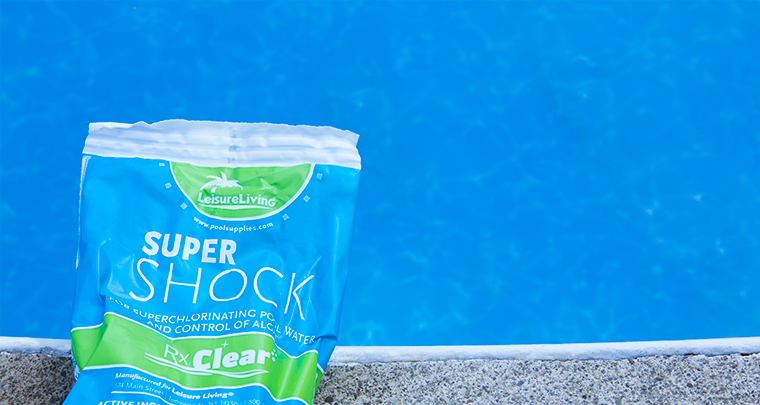The Beginner's Guide to Shocking Your Swimming Pool

Learning how to shock your pool is a small rite of passage for pool owners. Shocking your pool is an important part of keeping your pool water clean. Otherwise known as super chlorinating, shocking is the act of adding chlorine to your pool to quickly and dramatically raise your pool’s chlorine level. Normal chlorine levels in a swimming pool are between 1-3 ppm. When shocking your pool, your chlorine level jumps to between 5-10 ppm.
Adding this much chlorine at once destroys chloramines that form in your pool (which prevent your pool’s existing chlorine from sanitizing, and also cause the famous “chlorine smell”), and burns off organic matter in your pool water. This organic matter is what algae feeds upon in order to grow, so ridding your pool of this helps prevent the formation of algae.
How Do I Shock My Pool?
While some may advise that granular shock can be broadcast across the pool surface, it is recommended to mix and dilute the shock with a small amount of water before adding it to your pool. Some mixtures of granular shock have been known to cause stains or bleach damage on vinyl pool liners when they haven’t been diluted, so it is best to play it safe if your pool uses a liner. Liquid chlorine should always be diluted before being added to your pool.
To dilute your shock, fill a bucket or watering can with water and then add your liquid or granular chlorine. Mix it up and then pour the solution over the surface of your swimming pool.
Be sure to defer to the package’s instructions before adding any chemical to your pool, and avoid direct contact with the chemical, using rubber gloves and safety eyewear. Also make sure your other pool chemicals are balanced properly, as chemical balance greatly affects the sanitizing power of chlorine.
How Much Chlorine Do I Add to My Pool to Shock It?
Exact dosages of chlorine will depend upon your pool size and the type of chlorine you use.
- If you are using granular chlorine to shock your pool, you want to add 1 lb. of shock per 10,000 gallons of water
- If you are using liquid chlorine to shock your pool, you want to use 3½ quarts per 10,000 gallons of water
How Often Should I Shock My Pool?
The most honest yet vague answer to how often to shock your pool is “whenever your pool needs it.” In perfect conditions, a swimming pool should be shocked every 1-2 weeks. However, you may find the need to shock more often. We recommend that you shock your pool more frequently in the following situations:
- When you have particularly hot weather
- After your area receives a lot of rain
- If your pool has been used extensively
- Whenever you see algae start to form
As a general rule, if you see your pool water start to get hazy, or you start to see the formation of algae, it’s a good time to shock your pool.
When Should I Shock My Pool?
It is inadvisable to swim immediately after shocking. In fact, the pool should not be used for 8 hours after shocking. Additionally, UV rays tend to weaken chlorine’s effectiveness. For these reasons, it is best to shock your pool after sunset, particularly after you are finished using your pool for the day before going to bed. This allows the chemicals to work at their peak efficiency and then drop to safe levels overnight, returning your pool to normal by morning.
Do I Shock My Pool if I Use Bromine Instead of Chlorine?
Yes, chlorine should still be used to shock your pool, even if you use bromine instead of chlorine as your main pool sanitizer. While bromine provides certain advantages over chlorine as a pool sanitizer, chlorine is still a more effective oxidizer, making it more effective than bromine in killing and preventing algae. Shocking your bromine pool also gets rid of bromamines, the bromine equivalent to chloramines.
Do I Shock My Pool if I Use a Biguanide System?
A pool using biguanides as its primary sanitizer should still be shocked, but not with chlorine. Instead, biguanide systems need to be shocked with a liquid containing hydrogen peroxide as the active ingredient. Using this type of shock, a biguanide pool can typically be shocked once per month, barring any algae appearances.
It should be noted that shocking alone may not always prevent algae in your pool, in which case algaecides may need to be used. Regardless, with a little practice, shocking will become an easy part of your pool maintenance routine, and your water will remain cleaner, longer.






 Pools
Pools Spas
Spas Liners
Liners Equipment
Equipment Covers
Covers Accessories
Accessories Cleaning
Cleaning  Pool Fun
Pool Fun  Clearance
Clearance
